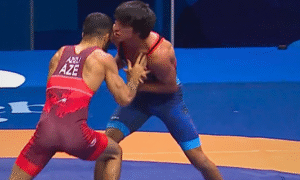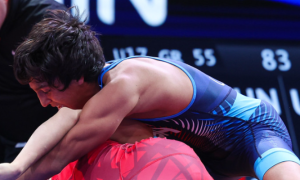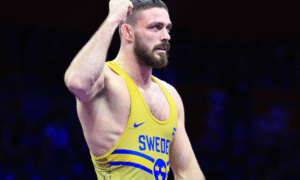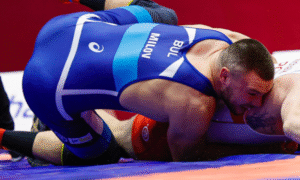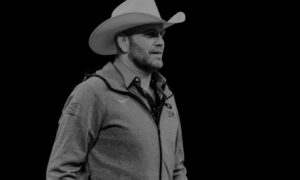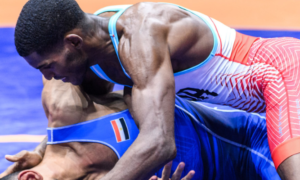The 2017 Cadet Greco-Roman World Championships are finally upon us and Team USA is putting one of its most capable squads in several years on the mat in Athens. The first item working in the Americans’ favor is that there are two returning World Team members — Malik Johnson (58 kg) and Cohlton Schultz (100 kg). Neither wrestler was able to medal at last year’s World Championships in Georgia, but both have grown considerably since then, and in more ways than one.
Johnson & Schultz
Johnson, who hails from Missouri and competes domestically for Team Punishment, jumped up two weight classes in 2017 and going by how he looked at the Cadet Trials three months ago, has raised his game. Unlike many age-groupers, Johnson doesn’t just try to hit “moves.” Rather, he is adept at fighting for positions that work for him and attacks from there. It’s not only a sign of maturity, but also an attribute that could see him give foreigners fits, so long as he pulls the trigger when good scoring chances arise, which is another thing he has going for him. Johnson converts takedowns to turns with more fluidity than most US Cadets and that is something he can and will need to do in order to advance on Monday.
Schultz, the youthful wunderkind with the hair that gets almost as much notice as his incredible ability, was ahead 1-0 over Yuri Nakazato (JPN) in his opening bout last year before getting tossed for four. He climbed back within a pair, but that was as close as he would manage. That kind of frustrating loss will likely not repeat itself in Athens.
To say the preceding 12 months leading up to now have witnessed a coming-of-age for the Coloradan would be an understatement. For starters, Schultz has garnered a substantial amount of experience overseas as of late, with medal-winning performances virtually everywhere he’s been. Whether or not you find this factoid important, but he also exacted dominant revenge over Tyler Curd (Missouri) to make this team. If you remember, Curd shocked Schultz in the Fargo quarters last year. When they met up in the Trials finals this past June, Schultz tech’ed Curd out in two straight, the second time frighteningly quick. The primary reason this is worth mentioning is simply because it demonstrates the enormous improvements Schultz has made since July of 2016. Curd is the furthest thing from a slouch — he’s a wonderful prospect in his own right. For Schultz to assert himself the way he did in Akron should serve as eye-opening evidence of what he brings to the table here.
Team preparation
However, it doesn’t end with Johnson and Schultz. While the rest of the Team USA Cadets may not possess the same experience internationally as those two athletes, the level of collective talent present in the lineup along with the training plan heading into the Worlds could be enough to make up for the lack of passport stamps. In conjunction with US Greco-Roman Operations Manager Gary Mayabb, World Team coaches Zac Dominguez and Lucas Steldt were able to provide the team with more time training together than is usually the case. Beginning in early June, Mayabb collaborated with US National Team head coach Matt Lindland for the sheer purpose of getting the Cadets more mat time at the Olympic Training Center in Colorado Springs. Instead of one solitary two-week camp, seven of the ten World Team members wound up sticking around for another week. Some broke out for Fargo soon after, some didn’t. Either way, most of the entire unit reconvened again in late-July in effort to ratchet up their preparation. But it’s the overall process that stands out. Most years see age-group World Teams have one camp and then split up until it’s time to compete. Not this year.
“We really did a lot of evaluations there and tried to move forward with certain areas of technique,” Mayabb said at the time. “For example, footwork and biomechanics were pretty important in that first camp. We wanted to see where they were at that point so we could skill-build the Cadets.”
And it wasn’t just the Cadets wrestling around with each other. Also at these camps were Juniors and Seniors. Once again, this wasn’t a happy accident. Lindland has been very aggressive when it comes to assimilating the age-group athletes with the Seniors and the fact that all three age divisions had been gearing up for their own World tournaments at similar times during the summer allowed for synchronicity. More than anything, these combined training sessions gave the Cadets a lot of opportunity to see where they stack up against wrestlers a step up from where they are, as well as provide the coaches with more time to observe.
“We had multiple opportunities to train our Juniors and Cadets alongside and with our Senior athletes,” said Lindland just after the conclusion of the first camp in early-July. “I think if you segregate your age groups and say, Well, this is a Junior camp or These are Senior camps, I think you really hurt the growth of your younger athletes because they are not getting to see where they’re at against that next age group. Putting them together lets them see that they are a lot closer than maybe they thought they were as far as closing those gaps.”
The tournament format
The 2017 Cadet Greco-Roman World Championships will be the first event on the United World Wrestling calendar featuring the two-day format with same-day weigh-ins. For example, on Monday, weigh-ins begin at 9:00am local time for the following weight classes — 50 kg, 54 kg, 58 kg, 63 kg, and 100 kg. Wrestling begins 90 minutes later. Those who qualify for the medal rounds will complete those on Tuesday, and another weigh-in will be held that morning (featuring a two kilogram allowance), with the same sequence repeating for the other weights their two days of action. This format is expected to go into effect for the Juniors and Seniors come January.
Though interesting in its own right, the revamped tournament format could also be looked at as a potential advantage for the US team, which is easy to figure out — they’re used to it. Each one of the American wrestlers boasts immense folkstyle experience, which means they have been well-accustomed to weighing in on the same day of a match or tournament. “Americans have been doing that for a long time,” Dominguez said. “Foreigners have not.”
The wrestlers
No question, the most important variable to all of this comes down to who is taking the mat. Every athlete Team USA is bringing is a serious, serious talent and just about all of them have sparkling domestic credentials in both international styles. What will matter more, of course, is how these wrestlers get after it this week. World competition does not offer a lot of tolerance for timidity and any hesitation to pull the trigger can prove costly, even in the early stages of a bout. That might not be an issue with this group (“These guys are fighters,” Lindland said last week). Every representative here is an attacker who should hopefully be buoyed by the confidence that their coaches and training have laid the necessary groundwork for success.
42 kg: Kase Mauger, Idaho (2017 UWW Cadet World Team Trials Champion, three-time Idaho Greco-Roman State Champion)
As is the case for most Cadet-level wrestlers, progress arrived quickly for Mauger. A very different wrestler from where he was at in 2016. He expressed a higher degree of confidence stalking in the tie-ups in Akron and it’s a part of the game that suits his style. Mauger tries to bring a little roughness to the position battles but moves slickly enough to where his scores appear more technical than physical. He’ll need the physicality more than anything else in this tournament.
46 kg: Dylan Ragusin, Illinois (2017 UWW Cadet World Team Trials Champion, two-time Fargo Cadet National Champion, 2016 UWW Cadet World Team Trials bronze medalist, 2015 Fargo Schoolboy National Champion, three-time Illinois Greco-Roman State Champion)
One of the more decorated athletes on the roster, Ragusin boasts the all-around Greco skillset that could help him nail down a medal. He’s after points, no doubt about it. But Ragusin brings an edge that suggests he’s equally happy for the fight, as if the battle of wills means just as much to him. He aims to assert himself in every way possible, you see that when he forcefully wedges inside, punches in underhooks, and straightens his position. Ragusin wants opponents to remember their time together and just yikes, you’ve got to respect that.
50 kg: Lucas Byrd, Ohio (2017 UWW Cadet World Team Trials Champion, 2016 Fargo Cadet National silver medalist, 2015 Fargo Cadet bronze medalist, three-time Ohio Greco-Roman State Champion)
Byrd is a gifted technician who can break out beautiful throws in a split second. It’s what he has been able to do domestically — crunch his way in, force counterpressure, and boom, there are his points. He also knows how to come back hard. Illinois’ future star Anthony Molton blitzed Byrd in their first bout before the Ohioan turned the tables in Match 2. A much tighter victory in the third round is what clinched his spot here. So, lesson learned. An attacking Byrd is tough to deal with and hopefully he remembers that.
54 kg: Ridge Lovett, Idaho (2017 UWW Cadet World Team Trials Champion, 2016 Fargo Cadet National Champion, 2015 Fargo Cadet All-American, seven-time Idaho Greco-Roman State Champion)
It’s certainly true that Lovett is not a one-trick pony, but he does own a lockdown two-on-one that has been his bread-and-butter. He can wrangle that thing from a distance or bully his way in and snatch it across his body. The tie-up makes opponents uncomfortable because Lovett can use it to either slide-by or drag into position to throw. His gutwrench has also been money in the bank when it matters most, as Byrd can attest to from last year’s Fargo final. But there’s more going on with Lovett than just that. He’s got a mean streak, too, which is good. Very good.
58 kg: Malik Johnson, Missouri (two-time UWW Cadet World Team Trials Champion, 2015 Fargo Cadet National Champion, two-time Missouri Greco-Roman State Champion)
Johnson’s performance at last year’s World Championships may not have given him the result he traveled across the globe for, but it did provide a glimpse at his intangibles. What makes Johnson special is that he doesn’t let his cage get rattled. If he is down by a few points, there is no panicking. Instead, Johnson collects himself and calmly but assuredly begins his comeback. That isn’t to say he won’t go for the home run should he need one, but his blood remains ice cold the entire time, or so it appears. An approach like that can win medals.

Phillips (red) works a two-on-one tie-up against Trevor Mansfield in the finals of the 2017 US Cadet World Team Trials. (Photo: Sam Janicki)
63 kg: Mason Phillips, Washington (2017 UWW Cadet World Team Trials Champion, 2017 Fargo Junior National Champion, 2016 Fargo Cadet National Champion, two-time Washington Greco-Roman State Champion)
Not even a full-timer (yet), Phillips took out NMU’s Alston Nutter in this year’s Fargo finals by deftly countering a front headlock attempt to land on top. It was a nice win, but the stuff that happened leading up is just as meaningful. Phillips demonstrated complete dominance in virtually each one of his matches prior to his first Junior final. He was composed, sure, but also brutal and unrelenting. Phillips was setting traps and chain-scoring like a monster. We saw this last year, too, but it’s a different look in 2017. If he can implement this part of his game tomorrow, look out.
69 kg: Mason Reiniche, Tennessee (2017 UWW Cadet World Team Trials silver medalist, 2016 Fargo Cadet All-American, 2017 Tennessee Greco-Roman State Champion, 2016 Southeast Regionals gold medalist)
Is Reiniche the Cadet version of Cevion Severado? The US sure hopes so. Reiniche fell to well-known Illinois stud Will Lewan in the Trials finals, but this is his spot now. How he puts his stamp on it is what matters. Has shown excellent strength and body awareness in his matches, with the only missing component being a lack of hardened Greco-Roman training. If Reiniche had the experience many of his domestic opponents have enjoyed, we’d be talking a trophy case full of hardware for him. He’s had a few months of intense programming at this point. It’ll be interesting to see what that new Greco microchip reads.
76 kg: Jake Hendricks, Pennsylvania (2017 UWW Cadet World Team Trials Champion, 2016 Fargo Cadet National silver medalist, 2015 Fargo Cadet All-American, four-time Northeast Regionals gold medalist)
A powerful, working-class throwback kind of wrestler. There isn’t a lot of flash in the way Hendricks goes about things. The last three years, he has shown that a) he can usually outmuscle opponents, which gives him the ability to control the pace and decide the tie-ups and b) an absolutely punishing front headlock that at the very least, drains the lifeforce out of his opponents. But Hendricks can move and scramble, too, as everyone saw in his Trials finals series with Christopher Foca. He won’t back down and definitely won’t be intimidated by anyone sporting more accolades than he. So long as Hendricks likes the big stage, a big performance isn’t out of the question.
85 kg: Ashton Sharp, Missouri (2017 UWW Cadet World Team Trials Champion, three-time Missouri Greco-Roman State Champion)
Sharp might very well be made for international competition. The scope is here. He’s got the throws, he has the lifts from top, and the eagerness required to go along with the offense. Against foreign opponents, he is going to need to get a little busier in the ties and not let himself be grinded down into a passivity fest. If Sharp has willing partners, as we like to say, he’ll have his chances to put points up on the board. The competition at 85 kilograms is fierce, for sure. But so is Sharp. Scoring is what wins at these things and he wants to do that. Badly.
100 kg: Cohlton Schultz, Colorado (two-time UWW Cadet World Team Trials Champion, 2017 UWW Junior World Team Trials Champion, 2015 Fargo Cadet National Champion, 2016 Fargo Cadet National bronze medalist)
It would be an exercise in redundancy to readdress all that Schultz has accomplished over the past 18 months. The medals he has won overseas hold the most importance, especially because a couple of them were at the Junior level. Add in the fact that following the Junior Worlds he remained in Europe to help out G’Angelo Hancock (Sunkist, world no. 16) and warm up Senior World Team members in Paris, and that should be all you need to know about what his deal is. This is his weight. Schultz is undersized at 120. He’s also a very serious candidate for gold and everyone in his bracket is aware of that.
Wrestling begins Monday at 10:30am local time (3:30am EST) with semifinals slated to start at 5:30pm (10:30am EST). The schedule repeats on Tuesday with the exception that the finals and medal matches from the previous day will proceed at 6:00pm (11:00am EST). The Greco-Roman finals/medal matches from Tuesday will begin at 6:00pm (11:00am EST) on Wednesday.
2017 Cadet Greco-Roman World Championships — Athens, Greece
Monday — 50 kg, 54 kg, 58 kg, 63 kg, and 100 kg
Tuesday — 42 kg, 46 kg, 50 kg, 69 kg, and 85 kg
Live streaming available in the United States on Trackwrestling.com
SUBSCRIBE TO THE FIVE POINT MOVE PODCAST
iTunes | Stitcher | Spreaker | Google Play Music | RSS



